The Real Peaky Blinders episode 1: Exploring the origins of the real Peaky Blinders phenomenon in Birmingham, starting with the first mention of the term in the popular press in 1890 and the street gangs that stretched as far back as the 1860s, when they were known as slogging gangs.
Through the experiences of a number of individuals, who we learn about through court and press reports, we build up a picture of the gang movement that has its roots in the working-class areas where territorial loyalty was all and gambling was a national pastime driven underground by Victorian middle-class morality. We follow the work of Professor Carl Chinn as he uncovers the stories of the real Peaky Blinders. We also interview several renowned experts on the gang phenomenon and Steven Knight, the writer of the Peaky Blinders drama, who based the series on his own family’s anecdotes.
The phenomenon arose in all the major British industrial cities, but Birmingham’s Peaky Blinders were the most notorious. With growing populations crammed into the new industrial slums, this territorial gang violence became an obsession of the press and the Victorian middle classes.
The Real Peaky Blinders episode 1
Economic hardship in Birmingham led to a violent youth subculture. Poor youths frequently robbed and picked the pockets of men walking on the streets of slum areas of the city. These efforts were executed through assaults, beatings, stabbings, and manual strangulation. The origins of this subculture can be traced back to the 1850s, in a time where Birmingham’s streets were filled with gambling dens and youth playing rough sports. When the police started to crack down on these activities due to pressure from the higher classes, the youth fought back, banding together in what became known as “slogging gangs”. These gangs frequently fought the police, and assaulted members of the public walking in the streets. During the 1890s, youth street gangs consisted of men between the ages of 12 and 30. The late 1890s saw the organisation of these men into a soft hierarchy.
The most violent of these youth street gangs organised themselves as a singular group known as the “Peaky Blinders”. They were likely founded in Small Heath, possibly by a man named Thomas Mucklow, as suggested by a newspaper article entitled, “A murderous outrage at Small Heath, a man’s skull fractured” (printed in the 24 March 1890 edition of The Birmingham Mail). The most powerful member of the Peaky Blinders was a man known as Kevin Mooney. His real name was Thomas Gilbert, but he routinely changed his last name.
Other prominent members of the gang were David Taylor, Earnest Haynes, Harry Fowles, and Stephen McNickle. Harry Fowles, known as “Baby-faced Harry”, was arrested at age 19 for stealing a bicycle in October 1904. McNickle and Haynes were also arrested at the same time, for stealing a bicycle and home invasion, respectively. Each was held for one month for their crimes. West Midlands police records described the three arrested as “foul-mouthed young men who stalk the streets in drunken groups, insulting and mugging passers-by”. Taylor was arrested at age 13 for carrying a loaded firearm.
Many gang members later fought in the First World War. Henry Lightfoot, the first person to be named as a Peaky Blinder, joined the British Army three times in his life and participated in the Battle of the Somme in 1916. One of the youngest gang members when he joined, Henry Fowler was years later buried alive in the trenches, and after being extricated, could not speak or see for some time following the war.
Notorious gangster Billy Kimber was also a former Peaky Blinder.




